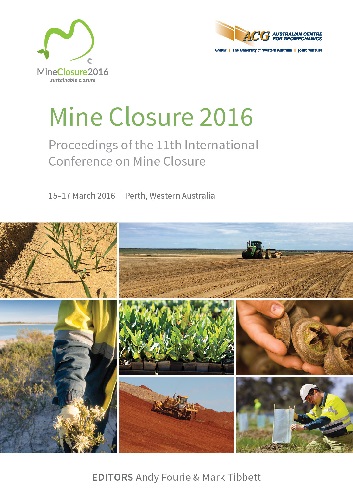Waste landform cover system and geometrical design — integration with waste placement and landform optimisation approach

|
Authors: Kemp, A; Taylor, I; O’Kane, M |
DOI https://doi.org/10.36487/ACG_rep/1608_08_Kemp
Cite As:
Kemp, A, Taylor, I & O’Kane, M 2016, 'Waste landform cover system and geometrical design — integration with waste placement and landform optimisation approach', in AB Fourie & M Tibbett (eds), Mine Closure 2016: Proceedings of the 11th International Conference on Mine Closure, Australian Centre for Geomechanics, Perth, pp. 141-148, https://doi.org/10.36487/ACG_rep/1608_08_Kemp
Abstract:
One of the foremost challenges in mine landform design is the design of stable waste landforms that provide geochemical and geotechnical stability that resist long-term erosion and degradation of cover systems. Surface instability can expose reactive waste and lead to acid and metalliferous drainage, increased sedimentation of downstream waters, cause poor revegetation or related environmental impacts. The landform surfaces are the interface between the mine landform and the surrounding environment and therefore affect long-term environmental impact. This paper focuses on practical design guidance from early concept development through to the quantitative assessments required for detailed design. This extends to discussion on overall geometry of landforms, veneer stability, cover system design and the selection of cover system materials. These factors should be considered together and integrated with internal waste landform design to provide confidence in design, and improve closure outcomes. Surface water is intrinsically linked with surface (in)stability and the landform features, such as cover system selection, plateau grading, selection of embankment profiles and drainage structures, require an integrated approach to ensure that the design meets the stability objectives. Landform cover systems are commonly adopted for closure to manage water and oxygen ingress. In many instances the cover system forms a critical component of the closure solution to limit/mitigate the impacts of acid metalliferous drainage, and to enable rehabilitation success. Cover systems are most effective when developed in unison with the landform construction and geometry to improve the stability of the cover system, to accommodate surface water management features, and to realise efficiency in materials scheduling. Embankment stability is affected by geometry, including slope lengths, gradients and catchments. Longer, shallower slopes have larger catchments and potentially more runoff, whilst shorter steeper slopes have less catchment but (owing to the steep grade) require less energy to mobilise waste. A balance needs to be reached for best performance which is unique for the specific material types and hydrological setting.
Keywords: waste landform cover system, waste landform design
References:
Barritt, R & Scott, P 2015, ‘Managing Waste Rock Storage Design, Can We Build a Waste Rock Dump that Works?’, in A Brown, C Bucknam, J Burgess, M Carballo, D Castendyk, L Figueroa, L Kirk, V McLemore, J McPhee, M O’Kane, R Seal, J Wiertz J, D Williams, W Wilson & C Wolkersdorfer (eds), Proceedings of 10th International Conference on Acid Rock Drainage and IMWA Conference 2015, Chile.
INAP 2015, Draft Global cover system design technical guidance document, July 2015.
Kemp, A, Taylor, I & Hancock, G 2014a, ‘Landform design for Pilbara mine site – why plan and design waste rock dumps for closure based on site-specific conditions?’, in Proceedings Life-of-Mine 2014, The Australasian Institute of Mining and Metallurgy, Melbourne, pp. 47–54.
Kemp, A, Taylor, I, Pearce, SR 2014b, ‘Integrated Geo-environmental Landform Assessment and Design Concepts— A Case Study’ in Mine Closure 2014 Proceedings of the 9th International Conference on Mine Closure, Johannesburg.
McKenna, G & Dawson, R 1997, ‘Landscape engineering for sustainable development’, Geotechnical Society of Edmonton Third Annual Symposium, Edmonton.
MEND 2012, Cold regions cover system design technical guidance document, MEND Report 1.61.5c, July 2012.
O’Kane, M & Baisley, A 2014, ‘Development of a global cover system design technical guidance document’, B.C. Mine Reclamation Symposium 2014, November 2014.
Pearce, SR & Lehane, S 2015, ‘Quantitative risk assessment tools to assist with waste management and placement guidelines’ in AB Fourie, M Tibbett, L Sawatsky & D van Zyl (eds), Mine Closure 2015 Proceedings of the 10th International Conference on Mine Closure, Canada.
© Copyright 2025, Australian Centre for Geomechanics (ACG), The University of Western Australia. All rights reserved.
View copyright/legal information
Please direct any queries or error reports to repository-acg@uwa.edu.au
View copyright/legal information
Please direct any queries or error reports to repository-acg@uwa.edu.au